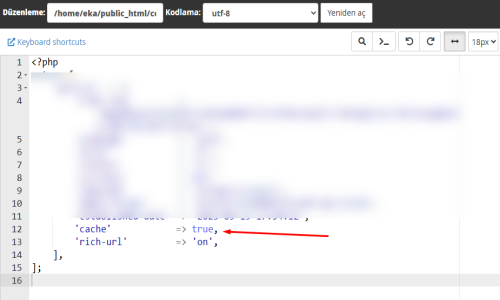
How to Fix Wisecp Cache Issue – Disabling Cache on coremio Systems
İçindekiler
How to Fix Wisecp Cache Issue – Disabling Cache on coremio Systems
Wisecp, a popular web hosting control panel, often uses caching mechanisms to improve performance. While caching generally enhances speed and efficiency, it can sometimes lead to issues, particularly with coremio systems. These issues can range from outdated information being displayed to unexpected errors. This guide provides a step-by-step approach to disabling caching on coremio systems to resolve these problems.
Understanding the Wisecp Cache Issue
Before diving into the solution, it's important to understand why caching can cause problems. Caching stores frequently accessed data in a temporary location, allowing for faster retrieval. However, if the cache isn't updated frequently enough or if there's a conflict with coremio's dynamic content, users may experience:
- Outdated information on the website
- Errors when submitting forms
- Inconsistent behavior across different pages
Identifying if Caching is the Culprit
Here's how to determine if caching is causing your issues:
- Clear your browser cache: This is the first step. If clearing your browser cache resolves the issue temporarily, caching is likely the problem.
- Test in incognito mode: Incognito mode disables browser extensions and often uses a clean cache. If the problem disappears in incognito mode, browser caching is a significant factor.
- Check Wisecp logs: Examine the Wisecp server logs for any cache-related errors or warnings.
Disabling Cache on coremio Systems: Step-by-Step Guide
Step 1: Accessing Wisecp Configuration Files
The first step is to access the Wisecp configuration files. This usually involves connecting to your server via SSH or using a file manager provided by your hosting provider. Locate the main configuration file, which is often named config.php or similar, within the Wisecp installation directory.
Step 2: Identifying Cache Settings
Open the configuration file in a text editor. Look for settings related to caching. These settings might be explicitly named cache_enabled, cache_lifetime, or include references to cache directories.
Step 3: Disabling the Cache
There are usually a few ways to disable the cache:
- Directly modifying the configuration file: Find the cache-related settings and change their values to disable caching. For example, change
cache_enabled = truetocache_enabled = false. - Commenting out cache settings: You can also comment out the lines related to caching by adding
//at the beginning of each line. This effectively disables the setting without deleting it.
Here's an example of how to disable a cache setting in config.php:
// Original setting:
// define('CACHE_ENABLED', true);
// Disabled setting:
define('CACHE_ENABLED', false);
Step 4: Clearing Existing Cache (If Applicable)
Even after disabling caching, you might need to clear any existing cached data. Wisecp often has a dedicated directory for storing cached files. Locate this directory (its name might be something like cache or tmp) and delete its contents. Be cautious when deleting files on your server and ensure you have a backup if necessary.
Step 5: Restarting Services
After making changes to the configuration files and clearing the cache, it's often necessary to restart the web server (e.g., Apache or Nginx) and PHP-FPM to ensure the changes take effect. You can usually do this through your hosting provider's control panel or via SSH using commands like:
sudo systemctl restart apache2
sudo systemctl restart php7.4-fpm (Adjust PHP version as needed)
Step 6: Testing the Changes
After restarting the services, thoroughly test your website to ensure the caching issues are resolved. Check different pages, submit forms, and verify that the data is displaying correctly. If the problems persist, double-check your configuration settings and ensure you've cleared all relevant caches.
Alternative Solutions and Considerations
While disabling caching can resolve immediate issues, it's not always the ideal long-term solution, as it can impact performance. Consider these alternatives:
- Configuring cache expiration times: Adjust the cache lifetime to ensure data is updated more frequently.
- Using cache busting techniques: Append unique query strings to your URLs to force browsers to reload the latest version of the files.
- Implementing server-side caching solutions: Explore more advanced caching solutions like Redis or Memcached for better control and performance.
Conclusion
Disabling caching on coremio systems within Wisecp can be a quick and effective way to resolve caching-related issues. However, remember that disabling caching can impact performance. Consider exploring alternative caching strategies to find a balance between resolving issues and maintaining optimal website speed. Always back up your configuration files before making any changes and test thoroughly after implementing any solutions.
 Turkey (Türkçe)
Turkey (Türkçe) Germany (German)
Germany (German) Worldwide (English)
Worldwide (English)




Yorumlar